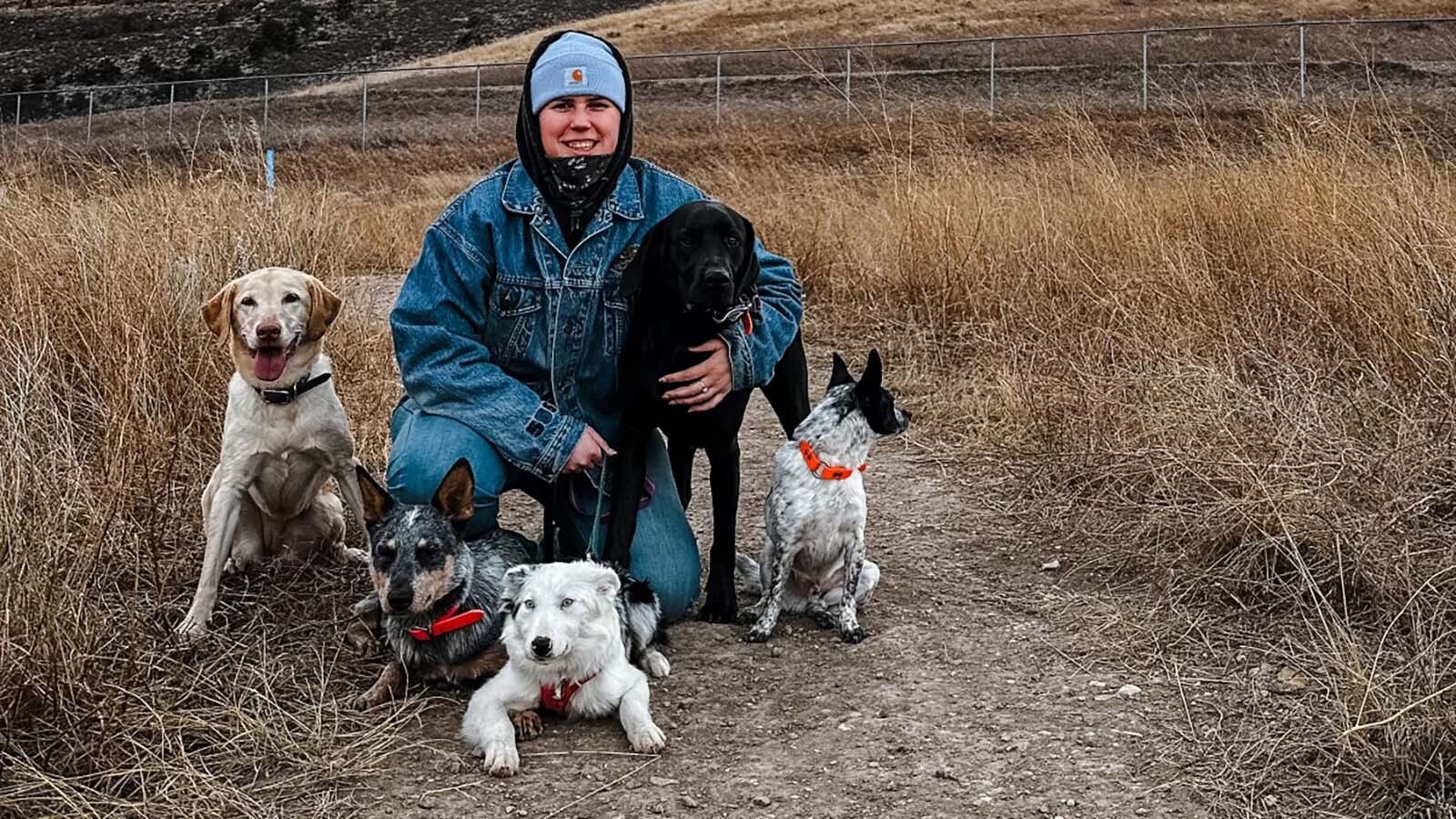CINCINNATI -- Despite Wyoming’s long legacy of paleontological riches, there’s at least one untouched chapter of its history. That makes the excavation teams from the Cincinnati Museum Center the first and only scientific team taking an interest in the potential of the Almond Formation in southwest Wyoming.
The Almond Formation, a rock layer exclusively found in Wyoming, has been overlooked for over a century. A handful of dinosaur fossils collected from the Late Cretaceous-aged rock have been little more than footnotes in the scientific literature.
After several summers of digging and prospecting in southwest Wyoming, the teams from the Cincinnati Museum Center have found a lot – and not much at all. But every piece has enormous potential.
“I would say we haven't found anything worthy of ‘trophy status,’ and I’m not sure that we will,” said Glenn Storrs, Associate Vice President for Science and Research and Curator of Vertebrate Paleontology at Cincinnati Museum Center. “The Almond Formation fills a time and geographic gap. We don't know much about the dinosaur fauna of the American West from this time, so there’s a lot to find and a lot of new stuff to learn.”
Broken Almonds
Storrs is “the dinosaur guy” in Cincinnati, even though the southern Ohio city isn’t known for its dinosaur discoveries. The museum’s dinosaur collection is growing with discoveries from Late Jurassic sites in southern Montana and the pieces and parts collected from the Almond Formation in southwest Wyoming.
Storrs said he and his team of fossil hunters, spearheaded by his student Ethan Cowgill, are fascinated by the Almond Formation for two reasons.
“No. 1, it hasn't been looked at much,” he said. “Number two, it fills a gap in both time and geographic area where we don't know much about the dinosaur fauna of the American West in that particular time frame.”
The Almond Formation dates to the Late Cretaceous Period, roughly 71 million years ago. At this time, there isn’t much more to say about it because it’s been overshadowed by other fossil formations in the Cowboy State.
Fossils from iconic dinosaurs like Tyrannosaurus and Triceratops are found in the 67-million-year-old Lance Formation. Fossils from their ancestors and a menagerie of other plants and animals are being found in the Almond Formation.
One reason the Almond Formation might have been overlooked is that it’s not known for producing impressive fossils. When legendary paleontologist Barnum Brown explored it in the 1930s, he found partial skeletons from hadrosaurs and horned dinosaurs but nothing that would make a centerpiece display for the American Museum of Natural History in New York City.
Storrs isn’t expecting Cowgill and the others to return to Cincinnati with a “trophy specimen” from the Almond Formation. They’re collecting as many fossils as possible to piece together the world of Wyoming as it was 71 million years ago
“Geographically, we know something from the southern U.S. at this time,” he said. “We know something from very northern U.S. and Canada. There is nothing from Wyoming in the middle of the continent, so there's new stuff to be learned and, potentially, new taxa to be found.”
A Little From A Lot
So far, the fossils recovered from the Almond Formation haven’t been visually impressive. Scientifically, they’re revealing a diverse paleo ecosystem filled with a menagerie of flora and fauna, new for Wyoming if not new to science altogether.
“We’re collecting a couple of the new hadrosaurs,” he said. “We don't know if they're new species yet, but they may give us some diagnostic material to give us an idea of what we're dealing with.”
They’ve found at least one diagnostic fossil: Denazinemys, a turtle previously found in the Late Cretaceous Kirtland Formation in New Mexico. Storrs said the Wyoming specimen, found this summer, is the northernmost fossil of Denazinemys yet found.
Another exciting discovery is Melvius, a species of bowfin fish that Storrs said is exceptionally well preserved. It could be the best fossil of this fish currently known.
“We've got lots of the skull, a lot of vertebrae, and things like that,” he said. “A student will present on that at a scientific conference this year.”
Other discoveries include several scutes from armored ankylosaurs, freshwater clams and bivalves, and teeth from crocodiles and various dinosaurs. They’ve also found dozens of fossilized plants, including fossils of giant metasequoia trees that were a staple of subtropical Wyoming for many millions of years.
None of these discoveries are “spectacular” to look at, but each one is a piece of the paleoecology puzzle. Storrs and the others are aspiring to do that, so every fossil counts.
“It's not particularly attractive, but it's an important data point in our global database of paleontological knowledge,” he said. “We are trying to get the picture of the whole fauna, the whole paleoenvironment for the Almond Formation towards the very end of the Cretaceous Period.”
Diagnostic Bits
One of the most exciting discoveries is the partial skull of a horned dinosaur. Storrs said several fragments were recovered from the frill, the large, flat bone at the back of the heads of horned dinosaurs like Triceratops.
What makes the fragmentary frill so exciting is that it might be a diagnostic discovery. Paleontologists might be able to use the fossil to determine if it belongs to a new or existing dinosaur species.
Diagnostic fossils are what every paleontologist wants, but they’ve been hard to come by in the Almond Formation. Most of the dinosaur fossils recovered from the Almond Formation are body parts that are very similar from species to species, so it’s almost impossible to determine which one they came from.
For instance, Storrs said the skulls of horned dinosaurs and hadrosaurs are the most diagnostic bones on their bodies. Unfortunately, all their hadrosaurs are headless.
"You really can't say much about dinosaurs, hadrosaurs in particular, without the heads,” he said. “It’s the heads that are distinctive here.”
That makes the partial frill an exciting discovery for the team and the Almond Formation. Determining which horned dinosaur it belongs to will take several years, but Storrs thinks it might be enough to solve the identity crisis.
“The frill of this horned dinosaur may have the diagnostic material to give us some idea what we're dealing with,” he said.
Wish List
When expectations are measured, everything is exciting. The initial discoveries from the Almond Formation will keep Storrs and his team busy for a long time, but that doesn’t mean they’ve stopped dreaming of what could be out there.
“We would love to find a big theropod,” he said. “There's a lot of activity and interest in tyrannosaurs, as you might imagine, and it’d be great to get a new tyrannosaur or something like that.”
Tyrannosaurs were the dominant carnivores in the Late Cretaceous. The Cincinnati Museum Center’s dinosaur display includes a skeleton of Daspletosaurus from Montana, a predecessor of Tyrannosaurus rex that lived around 70 million years ago and could potentially be found in the Almond Formation.
The goal of every paleontologist is a complete skeleton of any prehistoric animal, but Storrs isn’t letting himself have such high aspirations for the Almond Formation. It’s always possible but highly unlikely.
“When you're finding dinosaurs, finding a complete skeleton is pretty much impossible,” he said. “Finding a near complete one is very, very difficult. It would be nice to find such a thing in the Almond Formation, but to date, we haven't, and I don't expect that we will.”
But there’s no disappointment. That’s par for the course in paleontology, according to Storrs.
“That’s a typical state of affairs for paleontological field research,” he said.

Paleoecology Puzzle
Storrs and the Cincinnati Museum Center team have a lot of field and lab work ahead. The pieces and parts they’ve collected from the Almond Formation have to be prepared, consolidated, and scrutinized to determine what they are and what they reveal.
The Cincinnati Museum Center is partnering with the Carnegie Museum of Natural History in Pittsburgh to help prepare the specimens they’ve recovered from Wyoming. Pittsburgh is already home to Wyoming’s most famous dinosaur, Dippy the Diplodocus, found near Medicine Bow in 1899 and purchased by Andrew Carnegie soon after.
Even if none of the fossils from the Almond Formation come from new species, most will be new to Wyoming, adding to its already impressive paleontological record. That alone makes the ongoing excavation and research a worthy endeavor for Storrs.
“We’ll be buckling down, examining what we have, comparing it with the literature, and seeing if it's new or not,” Storrs said. “We expect to keep working in the Almond Formation for a while and hopefully get several significant research papers out of it. That will give us a better understanding of the paleoenvironment for Wyoming in the Late Cretaceous.”
Andrew Rossi can be reached at arossi@cowboystatedaily.com.










